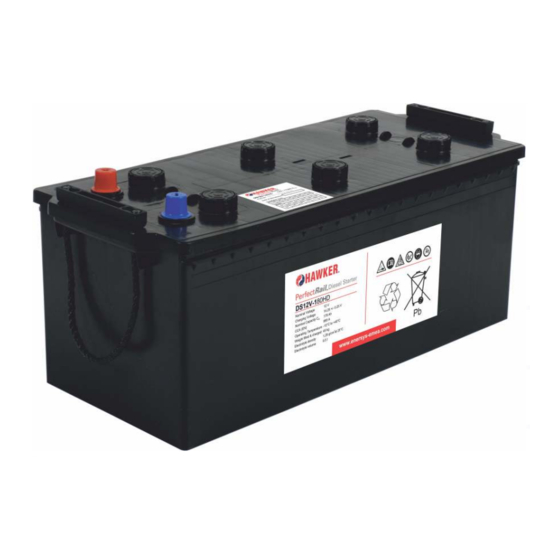
Table of Contents
Advertisement
Quick Links
Operation and maintenance instructions PerfectRail DS batteries
Rail engine starting flooded, flat plate, Pb-1.7%Sb/Pb-1.7%Sb 12V monoblocs
Rating Data
1. Nominal capacity C5
2. Nominal voltage
3. Discharge current
4. Nominal SG. of electrolyte
5. Rated temperature
SAFETY PRECAUTIONS
Pay attention to the operating instructions and keep
ź
them close to the battery.
Works on batteries must only be carried out by skilled
ź
personnel!
Use protective glasses and wear safety clothing when
ź
working on batteries.
Adhere to the current accident prevention rules in the
ź
country where the battery is used or DIN EN 50272-3,
DIN EN 50110-1.
ź
Keep children away from batteries!!
ź
No smoking!
ź
Do not expose batteries to naked flames, glowing embers
or sparks, as it may cause the battery to explode.
ź
Avoid sparks from cables or electrical apparatus as well
as electrostatic discharges.
ź
Acid splashes into the eyes or on the skin must be
washed immediately with an abundance of clean water.
After abundant flushing consult a doctor immediately!
ź
Clothing contaminated by acid should be washed in
water.
Ignoring the operating instructions, repair with non-original parts will render the warranty void.
All failures, malfunctions or defaults of the battery, the charger or any other accessories, must be notified to our After Sales Service.
1. Commissionning
The battery should be inspected to ensure it is in perfect physical condition.
Check:
1.
the battery cleanliness. Before installing the battery compartment has to be
cleaned.
2.
the battery end cables have a good contact to terminals and the polarity
is correct. Otherwise battery, vehicle or charger could be destroyed.
3.
the electrolyte level, the electrolyte level must
always be above the top of the separators.
Top up with demineralized water to the nominal level. Charge the battery (see
2.2.2) before commissioning. Only blocs with the same state of discharge (the
same voltage, tolerance as shown in the following table) should be connected
together.
Bloc voltage (V)
12
: See type
: See type
: See type
: 1.29 kg/l
: 25°C
Max. tolerance from
average value - ΔU
bloc
± 0.049
TM
Risk of explosion and fire
ź
Avoid short circuits: do not use non-insulated tools, do not
ź
place or drop metal objects on top of the battery. Remove
rings, wristwatches and articles of clothing with metal parts
that might come into contact with the battery terminals.
Electrolyte is highly corrosive.
ź
Do not tip the battery over.
ź
Batteries and monoblocs are heavy. Ensure secure
ź
installation! Only use suitable handling equipment. Lifting
hooks must not damage the blocs, connectors or cables.
Do not place batteries in direct sunlight without protection.
ź
Discharged batteries can freeze. For that reason, always
ź
store in a frost-free zone.
Dangerous electrical voltage!
ź
Pay attention to the hazards that can be caused by batteries
ź
After connecting, the terminals must be covered with grease as protection against
corrosion.
The specified torque loading for the bolts/screws of the end cables and
connectors are:
DIN conic post
8 ± 1 Nm
2. Operation
The nominal operating battery temperature is 25°C. Higher temperatures shorten
the life of the battery, lower temperatures reduce the available capacity. 55°C is
the upper temperature limit and batteries should not be used above this operating
temperature. The capacity of the battery changes with temperature and falls
considerably under 0 °C. The optimum lifetime of the battery depends on the
operating conditions (moderate temperature and discharges equal to or lower
than 80% of the nominal capacity C5). The battery obtains its full capacity after
about 10 charging and discharging cycles.
2.1. Discharge
Vent plugs on the battery must not be sealed or covered. Electrical connections
(e.g. plugs) must only be made or broken in the open circuit condition. To achieve
the optimum life for the battery, operating discharges of more than 80%, of the
rated capacity should be avoided (deep discharge).
ENGLISH
Advertisement
Table of Contents

Summary of Contents for EnerSys PerfectRail DS
- Page 1 ENGLISH Operation and maintenance instructions PerfectRail DS batteries Rail engine starting flooded, flat plate, Pb-1.7%Sb/Pb-1.7%Sb 12V monoblocs Rating Data 1. Nominal capacity C5 : See type 2. Nominal voltage : See type 3. Discharge current : See type 4. Nominal SG. of electrolyte : 1.29 kg/l...
- Page 2 The purity of the electrolyte must correspond to DIN 43530-2. 2.2. Charge 2.4. Battery Check PerfectRail DS batteries can be recharged with 50 Hz or HF charger. If you wish to use an existing charger with Wa, WoWa, IUIa, WUIa…profile, you should After a normal charge, measure: check that the profile is approved by our Technical Department.








Need help?
Do you have a question about the PerfectRail DS and is the answer not in the manual?
Questions and answers